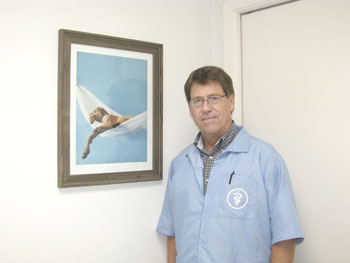Island Animal Clinic howls

William V. Bystrom, DVM, and owner of the Island Animal Clinic.
SUN PHOTO/LOUISE BOLGER
Anna Maria may only be a small island off the west coast of Florida but, as some Island residents will tell you, you can find most anything you need without crossing a bridge. And if you’re an animal lover whose pets also don’t want to cross the bridge, they can trot on over to the Island Animal Clinic where they have been taking of the Island’s pets for over 20 years.
The Island Animal Clinic is the only place on Anna Maria Island where you can get veterinary services for your pets. Dr. William Bystrom has just celebrated the 20th anniversary of his ownership of the clinic, which was already a well established business when he purchased it.
A graduate of the University of Missouri’s Veterinary School, he relocated to St. Petersburg working at the St. Petersburg Animal Medical Center. He started his own practice at the Palma Sola Animal Clinic on Manatee Avenue 25 years ago, and expanded on to the Island 20 years ago.
Bystrom provides all veterinary services including surgery both on the Island and off, if necessary. He specializes in artificial insemination for breeders, which he did for more than 15 years for Southeastern Guide Dogs.
Dr. Leigh Parisi has recently joined the staff at the clinic. She is a graduate of Louisiana State Univeristy and is qualified in all aspects of veterinary medicine with a specialty in avian and exotic species. In addition to Parisi, Bystrom has an experienced staff including his wife, Jeannie, who handles the books, veterinary assistants and technicians, as well as part time staff. Nancy Gupton, the clinic’s receptionist, has worked at the Clinic since before Bystrom and is undoubtedly the top dog.
The clinic also has boarding facilities and pet supplies, including food, shampoos, flea and tick medication and more. Bystrom reminds Island residents to make boarding reservations early for holiday weeks, especially in season.
Later in the year, the, clinic will host an open house to celebrate its 20th anniversary. In the meantime, having experienced and qualified veterinarians right in your back yard just gives Island residents another reason not to cross over the bridge. Island Animal Clinic, where you’ll find unconditional love of animals and a lot of wagging tails.


